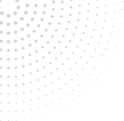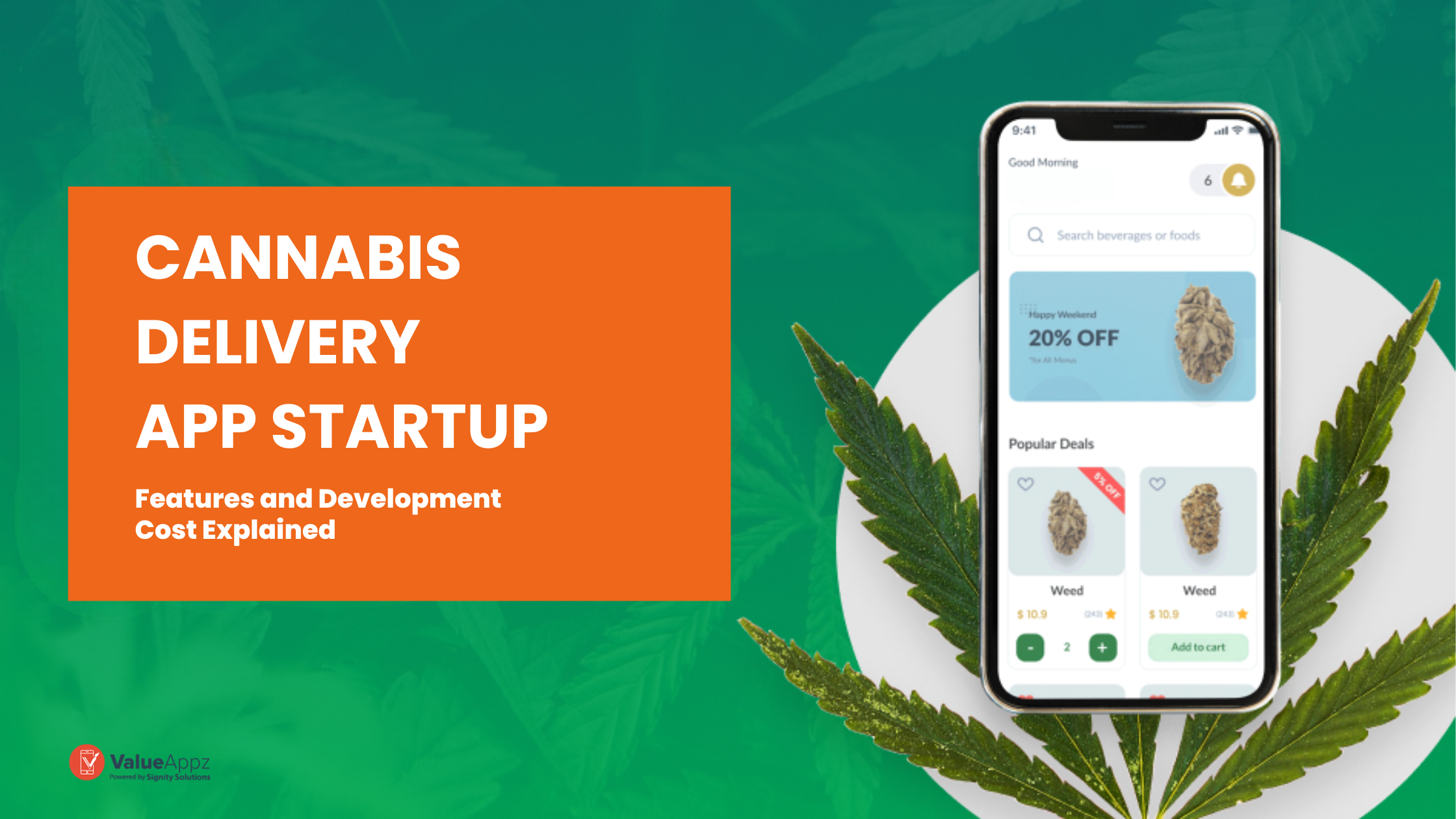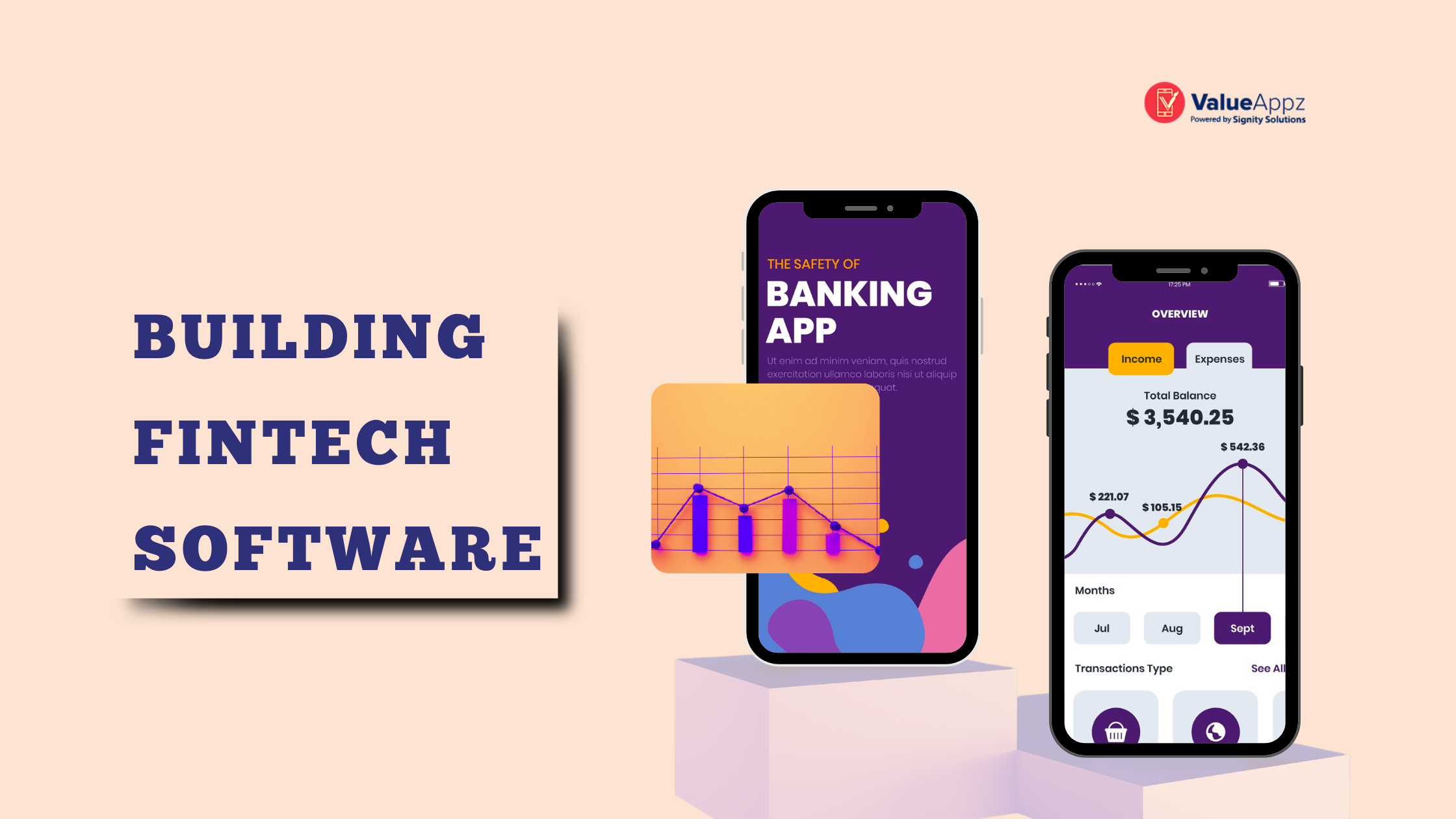Step-by-Step Process to Develop A Healthcare Platform
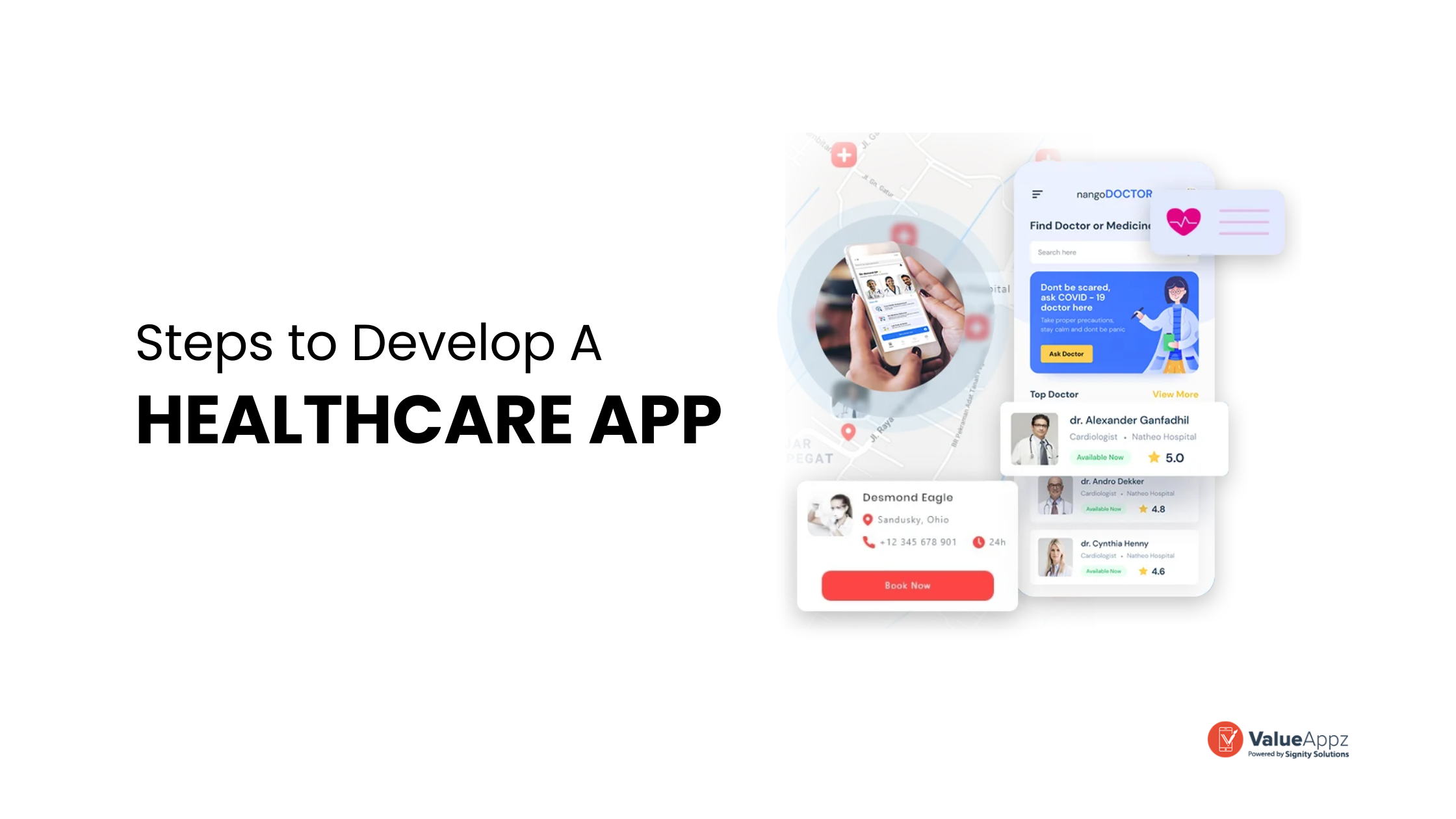
Quick Summary: Are you planning to invest in a healthcare and fitness app but are clueless about where and how to begin? Check this guide to develop a healthcare app and get all your answers. This blog will help you discover the types of apps, monetization methods, steps for development, and some of the most popular fitness apps to learn from.
The healthcare industry has changed over the years. From visiting doctors in the clinic to booking online appointments, this industry has developed with the changing technology. Further, online training sessions, yoga and meditation classes, diet plans, weight loss training, and more have become even more accessible with these apps.
Whether you are a dietitian, gym trainer, yoga practitioner, or a startup looking to bring these professionals and users together on one platform, building a fitness app will ensure your success.
Adding the right features to the app will further guarantee that you attract the right target audience and engage them with your platform well. But before you begin, you need to know the types of apps, cost for development, revenue models, and steps to build the app.
Our guide to developing a healthcare app will answer all these questions in detail, giving you a clear picture by the end of it.
Table of Contents
Health and Fitness App Stats Prove the Market is Multiplying
The health and fitness app market is multiplying. Several startups worldwide have started to invest in these apps as their demand is on the rise. Take a look at the important statistics in the online healthcare services industry.
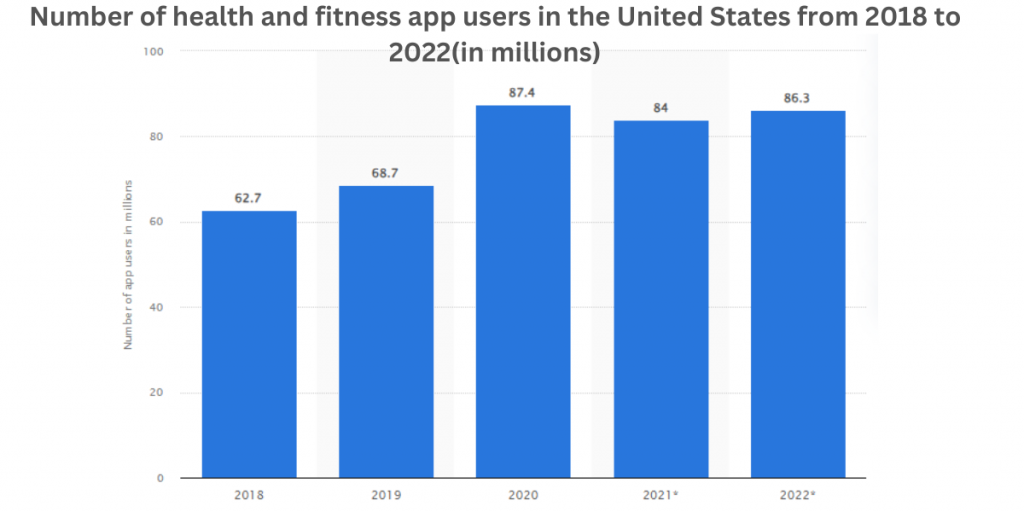
- The global fitness app market is projected to reach $14.7 billion by 2027, growing at a CAGR of 21.6%.
- Health and fitness is the 11th most popular category on the App Store.
- As of 2022, there were over 85 million registered users for the wellness app.
Certifications and Licenses Required to Launch A Healthcare Platform
Certifications and licenses required to build and launch a health and fitness app vary based on specific regulations and requirements of countries. It is vital to consult with legal and regulatory experts to ensure compliance.
| Country/Region | Data Protection Certification/Regulation |
|---|---|
| United States | Health Insurance Portability and Accountability Act (HIPAA) compliance may be required if handling protected health information (PHI). |
| European Union (EU) | General Data Protection Regulation (GDPR): Compliance with GDPR is essential for handling the personal data of EU residents, which includes health and fitness data. |
| Canada | Personal Information Protection and Electronic Documents Act (PIPEDA) governs the protection of personal information. |
| United Kingdom (UK) | Data Protection Act 2018 (DPA 2018): The UK’s implementation of GDPR, which governs data protection in the UK. |
| India | Information Technology (Reasonable Security Practices and Procedures and Sensitive Personal Data or Information) Rules, 2011: These rules prescribe data protection standards, and compliance is essential when handling sensitive personal data. |
| Australia | Privacy Act 1988: Applicable to organizations handling personal information, including health data. |
| Singapore | Personal Data Protection Act (PDPA): Applies to the collection, use, and disclosure of personal data, including health information. |
| South Africa | Protection of Personal Information Act (POPIA): Governs the processing of personal information, including health-related data. |
Benefits of Investing in a Healthcare App
In today’s digital age, having your healthcare and fitness app offers a multitude of advantages that not only enhance healthcare access but also boost your business revenue. There are some compelling benefits:

In today’s digital age, having your On Demand Medical Application offers a multitude of advantages that not only enhance healthcare access but also boost your business revenue. There are some compelling benefits:
1. Boost in Sales
The On-Demand Medical Application brings a surge in sales by providing unparalleled convenience to patients and users. With the ability to access online consultations effortlessly, your app becomes a revenue-generating powerhouse.
2. Accessibility for All
Our developers craft the app with a user-centric approach, ensuring it’s accessible to individuals of all backgrounds. The app appeals to a diverse user base, featuring an attractive UI design and user-friendly navigation, resulting in increased sales and revenue.
3. Native App Compatibility
The native app is a game-changer as it seamlessly runs on various operating systems. Users can effortlessly download, access, and book doctor consultations. The smoother the user experience, the greater your revenue potential.
4. Automation of Medical Facilities
The On-Demand Medical Application automates medical facilities, reducing unnecessary human efforts. It provides instant access to medical support and ambulance services with a simple click, streamlining healthcare processes. Healthcare providers, including doctors and clinics, are increasingly seeking such applications to automate their services, making your subscription model highly sought-after and contributing to your financial success.
5. Scalable Growth
With the On-Demand Medical Application, you can potentially grow. As more users and healthcare providers join the platform, your revenue opportunities expand exponentially. The subscription-based model and increased user engagement create a sustainable source of income.
6. Enhanced User Experience
The app’s user-centric design and features elevate the overall user experience. Patients can seamlessly connect with healthcare professionals, schedule appointments, and access medical services, fostering user loyalty and driving repeat business.
7. Efficient Healthcare Access
On-Demand Medical Application streamlines healthcare access, making it more efficient and convenient. Patients can receive timely medical assistance, consultations, and even ambulance services when needed, further enhancing the app’s appeal and increasing your earnings.
8. Competitive Edge
By offering an innovative healthcare solution, your app gains a competitive edge in the market. It positions you as a leader in digital healthcare services, attracting both users and healthcare providers and contributing to your sustained growth.
Ready to revolutionize healthcare industry? Launch your own on demand healthcare app today with expert development services from ValueAppz, for more information contact us today.
Healthcare VS Medical Apps- What is the Difference?
Before we begin to talk about healthcare apps in more detail, it is crucial to understand that medical apps and healthcare apps are two different platforms. Let’s look at how these two differ.
1. Purpose of the Apps
Healthcare apps: Healthcare apps are designed to provide various services, tools, and information related to health and wellness. Preventive care, overall health, fitness, nutrition, mental health, and total lifestyle management are the primary focus of these apps.
Medical apps: Medical professionals, including doctors, nurses, and other healthcare practitioners, are the target audience for medical apps, which are highly specialized. Clinical uses for them include patient care, diagnosis, treatment, and medical education.
2. User Base
Healthcare apps: Many people, including patients, those looking to improve their health, and those looking for general health information, frequently use healthcare apps. They are customer-focused and provide people with the tools they need to take charge of their health.
Medical apps: Medical apps are created for healthcare workers, such as physicians, pharmacists, radiologists, and others in specialized positions. These applications facilitate clinical care delivery, record-keeping, and medical decision-making.
3. Content and Features
Healthcare apps: Features like symptom checkers, medication reminders, mental health assistance, fitness tracking, meal planning, and general health information are frequently included in healthcare applications. They might incorporate wearable technology while emphasizing the promotion of healthy living.
Medical apps:
- Tools for managing patient records.
- Prescribing drugs.
- Doing clinical research.
- Diagnosing illnesses.
- Accessing medical databases.
- Referencing medical articles are more frequently found in medical apps.
Clinical guidelines, medication interaction checks, and specialized calculators are a few examples of advanced features.
4. Development and Maintenance
Healthcare apps: Healthcare apps can be developed by health and fitness app development companies. The frequency of updates and maintenance may vary.
Medical apps: Usually, healthcare software organizations with experience in medical software development create medical apps. To stay compatible with medical knowledge and standards, they need to be updated and maintained continuously.
Types of Healthcare Platforms Startups Can Invest In
As an entrepreneur considering investing in the health and fitness app market, you might have several questions. One could include how many types of healthcare platforms are there and what is the target market for all. In the section below, we have explained the major types of health and fitness apps that are used widely by audiences worldwide.
1. Yoga and Meditation App
One of the most prevalent types of healthcare platforms is the yoga and meditation app. If you provide yoga classes, the best way to connect with your clients is through an engaging app. Such a platform allows personalized sessions, uploading recorded videos, and much more. As a startup, you can also build a healthcare app that connects yoga and meditation trainers with the target audience. One best example is Headspace.
2. Workout and Exercise App
The reports have stated that the fitness app market will reach $14.7 billion by 2026. It is the workout and exercise apps that have helped several people gain access to the best of the best, even without moving out of the house. From one-to-one sessions to online appointments with professionals, apps like Nike Training Club have solved the problems for many.
3. Tracking and Monitoring App
Another in demand healthcare app is the tracking and monitoring app. From tracking calories to steps and monitoring daily physical activities, the demand for such apps is vast, and so is the market. Building a tracking and monitoring app that provides great features like nutrition tracking, steps count, etc., will engage the relevant target market towards the app.
4. Nutrition and Diet App
With time, everyone has become conscious about what they eat daily. The market revenue in the nutrition app market is expected to reach a volume of US$8.29bn by 2028. Due to this awareness, the demand for such apps is on a constant rise. Whether you personally provide nutrition and diet tips or are an entrepreneur looking to enter this market, building an app should be your priority.
5. Sleep Cycle App
Sleep issues have taken the world by storm. A chaotic lifestyle and stressful work have disturbed the sleep patterns of everyone. Other than medications, several apps have been launched in the market to help people maintain a proper sleep cycle.
Apps like SleepScore, Pillow, and SleepWatch have helped millions of users with their sleep. As an entrepreneur, you must explore business opportunities in this growing industry.
6. Personal Trainer App
Are you a personal trainer with limited clients? With a robust personal trainer app, you can attract a target audience from various areas. The best part? They do not have to visit you. You can take online sessions and answer their queries.
App Architecture and Detailed Feature List of a Healthcare Platform

1. Features of Patient Care App
The Patient App is the primary interface through which patients can access a variety of healthcare services. The app is designed to provide patients with a seamless and user-friendly experience, allowing them to easily schedule appointments, view medical records, and communicate with healthcare providers. Some of the key features of the Patient App include:
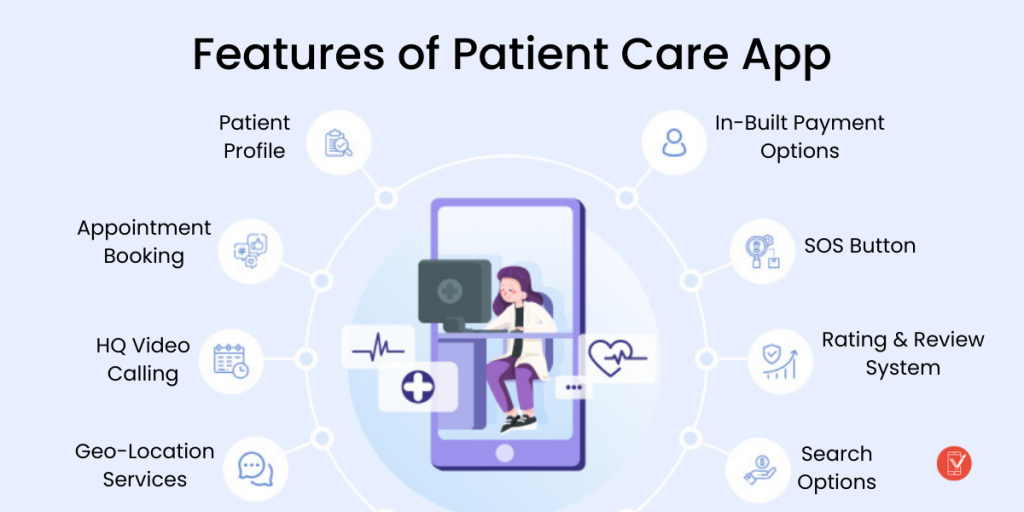
- Patient Profile: Patients create a detailed profile with essential information, including name, age, gender, contact details, location, and the type of disease they are dealing with.
- Appointment Booking: Enables patients to book appointments with doctors, helping them schedule face-to-face consultations at their convenience.
- HQ Video Calling: Facilitates high-quality video calls between patients and doctors, ensuring clear video and audio transmission for effective remote consultations.
- Geo-Location Services: Utilizes geolocation to help patients locate a doctor’s clinic and provides navigation directions to reach the destination.
- In-Built Payment Options: Allows patients to make payments using various methods such as Google Pay, Amazon Pay, UPI, net banking, and in-app wallet for hassle-free transactions.
- SOS Button: An emergency feature that connects patients with nearby ambulance services in critical situations, ensuring prompt medical assistance.
- Rating & Review System: Allows patients to rate and review their consultation experience with the assigned doctor, sharing feedback for future reference.
- Search Options: Empowers users to search and filter doctors based on their specific medical conditions, helping patients find the right healthcare professional.
2. Features of Doctor App
Now that we have discussed the features of the Patient App, let’s move on to the features of doctor’s app. it’s designed to help healthcare providers manage their appointments, medical records, and communication with patients. This section will discuss its features in more detail:
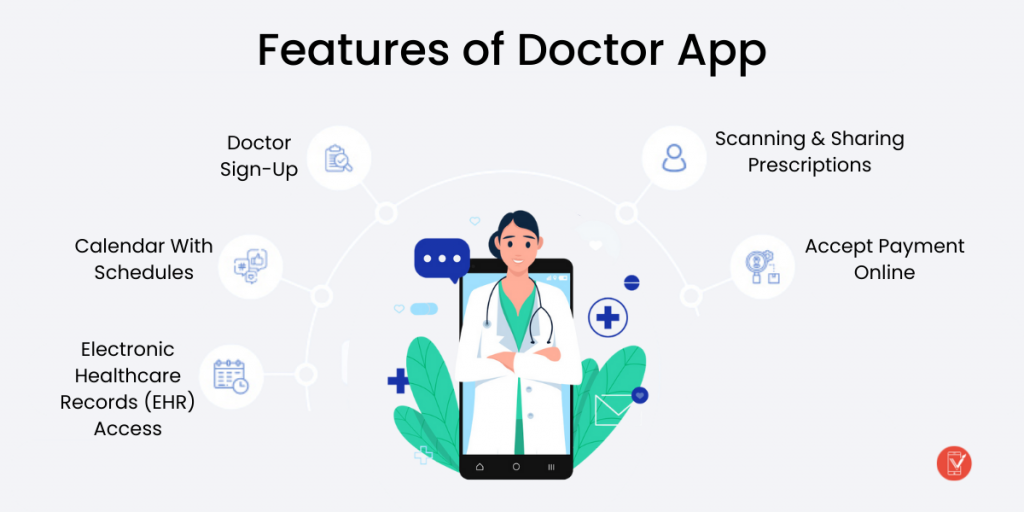
- Doctor Sign-Up: Doctors register with the app by providing information like their name, location, service charges, years of experience, and areas of expertise.
- Calendar With Schedules: Offers a calendar feature for doctors to manage their appointments, view patient bookings, and effectively schedule their consultations.
- Electronic Healthcare Records (EHR) Access: Provides access to Electronic Healthcare Records (EHR) to display vital patient information, aiding doctors in accurate diagnosis and treatment.
- Scanning & Sharing Prescriptions: Enables doctors to scan and share documents with patients, including prescriptions, diagnosis reports, lab test results, and medical documents.
- Accept Payment Online: Allows doctors to receive payments from patients through various online methods, including e-wallets and bank transfers.
3. Features of Admin Panel
The Admin Panel provides a comprehensive set of tools for managing the entire healthcare ecosystem, including patients, doctors, appointments, and medical records. Some of the key features of the Admin Panel include:
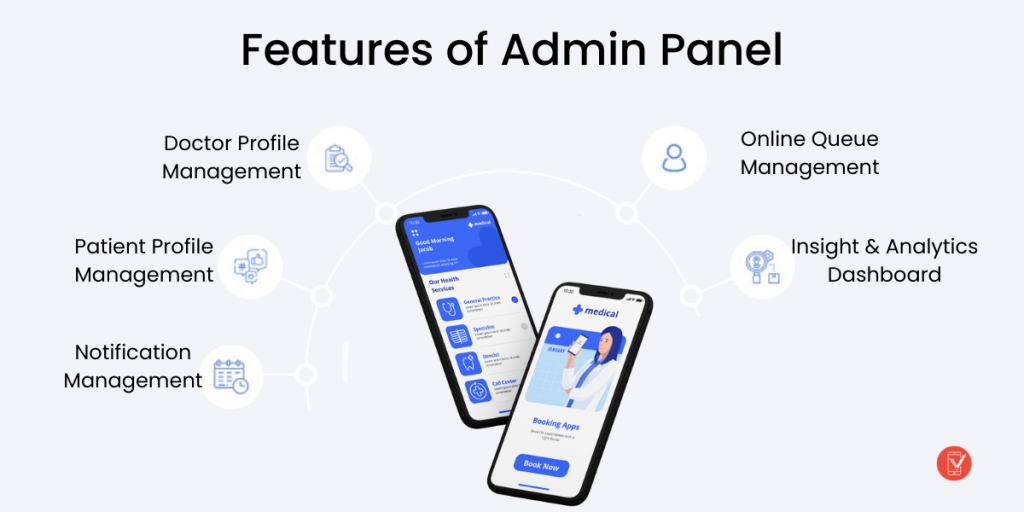
- Doctor Profile Management: Admins manage doctor profiles, including the ability to approve or reject incoming consultation requests, ensuring the quality of healthcare providers.
- Patient Profile Management: Provides admins with the capability to add, edit, or replace patient profiles as needed, ensuring a well-balanced user base.
- Notification Management: Allows admins to send notifications to patients and doctors, manage subscriptions, and notify users about renewal dates and important updates.
- Online Queue Management: Admins can oversee the waiting list of doctor appointments, assign custom priority appointments to patients upon request, and optimize appointment scheduling.
- Insight & Analytics Dashboard: A comprehensive visual dashboard displaying data such as sales, the number of doctors, current waiting lists, subscription renewals, and more. This feature assists admins in making informed decisions and optimizing the platform’s performance.
Have specific features in mind for your healthcare app? ValueAppz specializes in customizing solutions to fit your unique needs. Contact us today to bring your vision to life for a more personalized and effective healthcare experience!
Some of the Most Popular Healthcare Platforms Worldwide
Before you invest in the healthcare industry, you must look at the top apps in the market. It will help you understand how the process works and what exactly are the demands of your target audience. Below are some of the most popular healthcare platforms worldwide.
1. WebMD
Users of the WebMD app can access an extensive collection of health-related resources, such as details on diseases, symptoms, and therapies. In addition to reading articles on various health-related subjects and locating local healthcare facilities and providers, users can utilize a symptom checker to obtain insight into possible health problems.
With the help of useful healthcare information, users will be able to make well-informed decisions regarding their own health with WebMD.
2. MyFitnessPal
MyFitnessPal is one of the widely used health and fitness apps. In 2022, the platform earned a revenue of $247 million. With the help of MyFitnessPal, users can check their fitness and calories, gain muscle, or keep up a healthy lifestyle. It contains an extensive database of food and exercise activities and can easily log food using a barcode scanner.
Additionally, MyFitnessPal offers a premium membership with extra features like customized meal plans and recipes.
3. Fitbit
Fitbit is a wearable activity tracker that monitors a user’s sleep, steps, distance traveled, and calories burnt. It also features an integrated GPS and a heart rate monitor. Fitbit connects to a smartphone app that gives users comprehensive information about their sleeping and activity habits. The app also provides premium features like personalized health coaching and guided exercises.
Step-by-Step Process to Develop a Healthcare App
To develop an On Demand Medical Application, these steps must be followed to analyze how this kind of platform is developed including each aspect overview:
1. Define Clear Objectives:
- Identify the Core Purpose: Determine the primary goal of the healthcare platform, whether it’s connecting patients with healthcare providers, providing telemedicine services, managing medical records, or offering a combination of these.
- Target Audience: Define the target audience, such as patients, doctors, clinics, hospitals, and other healthcare providers. Understanding their needs is crucial.
2. Market Research:
- Competitive Analysis: Conduct a thorough analysis of existing healthcare platforms to understand their features, strengths, weaknesses, and pricing models. Identify gaps and areas for improvement.
- User Feedback: Gather feedback from potential users and healthcare professionals to ensure the platform addresses their pain points and provides value.
3. Technology Stack:
- Select the Right Technology: Choose a technology stack suitable for your platform’s requirements, considering factors like scalability, security, and compatibility with various devices and platforms.
4. Design and User Experience (UX):
- User-Centric Design: Create an intuitive and user-friendly interface that simplifies navigation and ensures a positive user experience.
- Prototyping and Testing: Develop prototypes and conduct usability testing to refine the design based on user feedback.
5. Development:
- Front-End and Back-End: Develop the front-end using technologies like React or Flutter for a mobile-friendly interface. For the back end, use robust technologies such as Node.js, Python, and PHP.
- Database: Implement a secure and scalable database system for storing patient records, appointments, and other healthcare data.
- Security and Compliance: Ensure strict security measures and compliance with healthcare data privacy regulations like HIPAA or GDPR.
- Telemedicine Features: If offering telemedicine services, integrate video conferencing and messaging features securely within the platform.
6. Testing:
- Quality Assurance: Conduct thorough testing to identify and fix bugs, security vulnerabilities, and usability issues.
- Performance Testing: Ensure the platform can handle high traffic loads and provide a seamless experience.
7. Compliance and Security:
- Data Privacy: Comply with healthcare data privacy regulations and implement encryption and access controls to protect patient data.
8. Deployment:
- Cloud Hosting: Choose a reliable cloud hosting provider for scalability and reliability.
- Cross-Platform: Deploy the app on major platforms like iOS, Android, and the web.
9. Marketing and User Acquisition:
- Marketing Strategy: Develop a comprehensive marketing strategy to attract both healthcare providers and patients to your platform.
10. Maintenance and Updates:
- Continuous Improvement: Regularly update the platform based on user feedback and industry trends to stay competitive.
11. Legal Considerations:
- Legal Framework: Consult legal experts to ensure compliance with healthcare laws and regulations in your target regions.
Monetization and Revenue Models of Health and Fitness Apps
As a service provider or an entrepreneur, how do you make money with your health and fitness app? All the major apps in this industry use various methods to generate revenue. These are listed below.
1. Subscription Model
The subscription model is one of the most popular methods in health and fitness apps. Users of health and fitness apps that use the subscription model pay a regular amount, usually monthly or annually, to access premium content and services. It can include customized exercise regimens, dietary advice, and unique features that improve the user’s overall fitness level.
2. In-App Purchase
In-app purchases refer to the sale of extra features or content from within the app, such as advanced monitoring capabilities, extra workout routines, or dietary plans. Users can do it to upgrade their app experience with one-time purchases, which can be a significant source of income.
3. Partnership and Sponsorship
Collaborating together with gyms, fitness influencers, and businesses can open up sponsorship and revenue-sharing opportunities. These collaborations may entail reciprocal advertising, co-branded content, or collaborative promotions.
4. Advertisements
To make money, a lot of fitness and health applications include advertising. It can involve sending consumers interstitial, banner, or video advertisements. Ad clicks, views, and interactions bring in money for the app, and if the user base is extensive and active, the revenue stream can be substantial.
5. Affiliate marketing
Through partnerships with fitness product companies and user promotion of their goods and services, health and fitness apps can generate revenue. It means that the app’s business strategy is performance-based; when users use its affiliate links to make purchases, the app gets paid a commission.
6. Data Licensing
Applications may gather and anonymize user data, which can then be sold to health and wellness businesses for use in product development, marketing, and research. To keep users’ trust, this model should prioritize user privacy and adhere to important data protection laws.
Ethical Considerations and Patient Privacy
Patient privacy and ethical considerations are critical while developing health and fitness apps. To safeguard consumers’ well-being, ethical issues include:
- Dispelling false information.
- Encouraging safe and advantageous behaviors.
- Offering accurate, evidence-based information.
In addition, patient privacy must be protected because health information might be very sensitive. Strict adherence to data protection laws, user consent for data collection, reliable encryption, secure storage, and transparency regarding the use of personal health information are all requirements for developers in the healthcare technology industry. Confidentiality and security of user data must be prioritized to foster trust and maintain the highest ethical standards.
Cost to Develop a Healthcare App
The average cost to develop a healthcare app with these capabilities is projected to be between $25,000 and $50,000. However, the development cost could go over $100,000 if it is decided to add sophisticated features like geolocation monitoring and AI-powered in-app conversation.
This cost estimate takes into account various critical elements, including user interface design, backend infrastructure, stringent security measures, feature complexity, and the integration of cutting-edge technologies. It’s important to note that the precise cost may vary based on your project’s unique requirements and customization needs.
ValueAppz- The Best Health and Fitness App Development Company
ValueAppz provides top-quality fitness app development services. Our reliable solutions meet the needs of healthcare providers and patients. Rest assured that your healthcare app will be developed and deployed to the highest standards. We offer excellent value for money with our competitive pricing model. Contact us today to bring your healthcare app vision to life.
Key Takeaways
- Health and fitness apps have revolutionized healthcare by increasing accessibility to services. Developing a fitness app with the proper features and audience in mind guarantees success.
- The market for fitness and health apps is expanding rapidly; by 2027, it’s expected to reach $14.7 billion.
- Region-specific licenses and certifications differ; speak with specialists to ensure compliance with data protection laws.
- In addition to automating healthcare and offering scalability, user-friendliness, efficient access, and a competitive edge, healthcare and fitness apps also increase sales and improve accessibility and native app compatibility.
- Medical apps provide professionals with clinical help and education, whereas healthcare apps concentrate on well-being. Comprehending the distinction is essential for developing applications.
Frequently Asked Questions
Q1. How do I create a health and fitness app?
To create a health and fitness app, follow the steps below:
- Define clear objectives
- Do market research
- Choose technology stack
- Plan UI/UX
- Develop the app
- Test the health and fitness app
- Launch and market
Q2. How much does it cost to build a fitness app?
The average cost of building a fitness app ranges between $25,000 to $50,000. The price can further vary depending on app design, platforms, features, etc.
Q3. What is needed for a fitness app?
Essential features for a fitness app include personalized experience, registration and sign-up, user profile, goal setting, tracking metrics, etc.
Q4. How do I create a wellness app?
To create a wellness app:
- Research app idea
- Validate the app idea
- Design the UI/UX
- Choose the features
- Hire a team of professionals
- Develop, test, and launch
Q5. How do you launch a fitness app?
To launch a fitness app, develop a user-friendly app with workout routines, tracking features, and nutrition tips, then market it through app stores and social media to reach your target audience.
THE AUTHOR
Ruby
As an author with a background in business analysis, I bring a unique perspective to my blogs, blending analytical insights with a love for straightforward, engaging writing.

Get ready to digitally transform your business.
Let our team help take your business to the next level. Contact us today to get started on finding the perfect solutions for your business needs.


